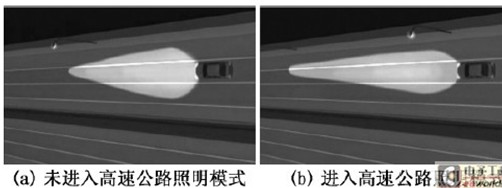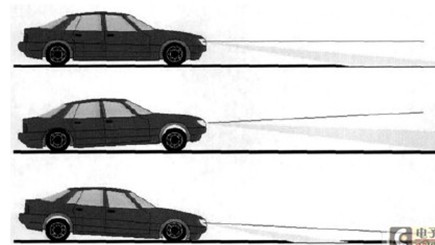Introduce the background of the Adaptive Front-lighting System (AFS) and the development of domestic and foreign development; analyze the 6 different lighting modes of AFS in detail: default lighting mode, highway lighting mode, country lighting mode, city Lighting mode, corner lighting mode and bad weather lighting mode; For the above functions of AFS, the hardware structure of the control circuit is given. The system consists of sensor group, transmission path, processing unit and actuator. Through the theoretical explanation and practical analysis of AFS, it provides a reference for the further development of AFS technology in China. 1. 3 country lighting mode
introduction
Car headlights are an important part of safe driving. People are increasingly demanding all aspects of headlamps. However, traditional headlamps only have two fixed lighting modes, low beam and high beam, which cannot meet customer needs.
If the car is turning, due to the limitation of the illumination angle of the traditional headlights, there is a dark area of ​​illumination, which will affect the driver's judgment on the obstacles on the curve; when driving on a rainy day, the water on the ground will reflect the light of the headlights of the oncoming vehicle. Cause the driver to dazzle and so on. Due to the existence of these problems, the probability of a car accident at night is twice that of the day. In order to solve these existing problems, a new headlamp system, the Adaptive Headlamp System (AFS), was put on the development agenda. The system can automatically adjust its own light distribution mode according to the changes of the surrounding environment, providing a more suitable illumination range, illumination distance and illumination angle, and improving driving safety and comfort.
AFS has been listed as Euro 1EK (EUREKA) project No. 1403 since 1992, and major European car companies and some companies in the US and Japan have participated in this project. In 2003, Italy's Magneti Marelli headlights installed dynamic adjustment lights on the car, laying the foundation for AFS. France's VALEO has also developed its own AFS. Germany's Hella company has achieved the most fruitful results. At present, many luxury cars, such as the BMW W5 series, the Mercedes-Benz E-Class, the Audi A8, and the Lexus R series, have been equipped with some functions of the AFS system. Domestic start on AFS late, Shanghai Xiaohao Auto Lamp Co., Ltd., Shenyang North Auto Headlight Auto Steering Factory and Tianjin Ouhua Auto R&D Center and other institutions are conducting independent research and development, but there is no mass production and lack of core intellectual property rights. . Since the European and American countries did not consider the weather of sandstorms, we have studied the AFS under the dust storm conditions under the advice of Chery.
1 AFS features
AFS is a smart headlamp system that actively adjusts the headlamps to suit the environment based on changes in the surrounding environment. In the following, the functions of AFS will be described in detail in six lighting modes for different environments.
1. 1 default lighting mode
In the default mode, the AFS headlamps do not make any horizontal and vertical adjustments, but automatically turn the headlights on or off depending on how the light sensor senses light. For example, when the vehicle passes through tunnels and bridges during the day or encounters inclement weather, the headlights automatically turn on to supplement the lighting. When the light intensity drops to a certain size at dusk, the headlights will automatically turn on, which seems to be able to sense the coming of the night; on the contrary, when the light comes to a certain level when the dawn comes, the headlights will automatically turn off.
1. 2 highway lighting mode
When the car is on the road and finds danger, the driver's first reaction is braking. The driver finds that the time from the emergency to the braking effect of the brake is called the reaction time. The distance the vehicle travels at the initial speed during the reaction time is called The reaction distance, the distance traveled by the vehicle from the moment the brake is applied until the vehicle stops, is called the braking distance. The reaction distance and braking distance are proportional to the initial speed of the car. The braking distance is the sum of the reaction distance and the braking distance, and the braking distance must be within the lighting area of ​​the headlight to ensure safe driving of the car.
When the vehicle is driving on the highway, the speed is very fast, the vehicle density is relatively low and the lateral interference is less, so the headlights are required to be farther and narrower, and the higher the speed, the longer the light type, so that Identify obstacles ahead in advance to avoid traffic accidents. When the vehicle enters the highway and the speed is > 70km / h, AFS knows this information through the vehicle speed sensor or GPS, and then realizes by raising the level of the low beam. And as the speed of the car accelerates, the low beam will be adjusted higher to ensure that danger can be found outside the safe braking distance. Figure 1 shows the light pattern of the headlights before and after entering the expressway. As can be seen from Figure 1, the lighting effect of the vehicle during AFS operation is significantly better than when it is not working.

There are many forks in rural roads, and the light is dark, so it is inconvenient to find edge obstacles in time. Some of the roads are also rugged and undulating, causing the body to tilt. As shown in Figure 2, the tilt of the body has a great influence on the pitch angle of the headlights.
